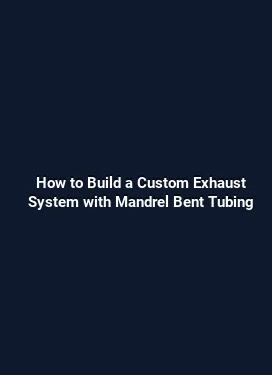How to Install Electronic Exhaust Cutout Valves for Dual Mode Sound
Electronic exhaust cutout valves offer a practical way to switch between a stealthy, quiet exhaust and a louder, more aggressive tone on demand. This guide walks through a thorough installation that emphasizes proper fitment, electrical safety, thermal management, and reliable operation without compromising engine efficiency or drivetrain integrity. Whether you’re upgrading a performance car, a daily driver, or a project vehicle, the steps outlined below help ensure a secure, durable setup that performs consistently under different driving conditions.
Understanding Electronic Exhaust Cutouts

Electronic exhaust cutouts are a compact valve assembly placed in the exhaust path that can divert flow either through a secondary exhaust route or by opening a bypass around a muffler segment. When activated, the valve creates a noticeably different sound signature and, in many configurations, a slight change in backpressure. While the concept is relatively simple, the implementation requires careful consideration of exhaust routing, heat management, and the electronic control that drives the valve motor.
Most systems employ a pair of essential components: a valve body with a motorized actuator and a control interface that accepts a switch or signal to open and close. A robust installation also relies on weatherproof wiring, secure mounting points, and shielded cables to protect against heat exposure and road debris. A well-executed setup ensures repeatable operation, minimizes rattle or vibration, and avoids unintended openings that could occur from electrical interference or mechanical wear.
Components Included

Typical kits provide a valve housing, mounting brackets, gaskets, hardware, a wiring harness, a switch or remote activator, a controller module, and in some cases a fuse tap or relay. The valve’s electrical connector is designed to withstand high temperatures near the exhaust, but protective insulation and strategic routing are still essential. Some kits include a temperature sensor that helps prevent operation when the exhaust is too cold or during startup, protecting the valve from thermal stress and reducing the risk of misfires or electrical faults.
Quality matters: a well-made valve assembly uses corrosion-resistant materials, sealed bearings, and lubricants compatible with automotive exhaust temperatures. Prior to installation, inspect the kit for missing fasteners or damaged seals, and verify compatibility with the vehicle’s exhaust diameter, mounting spacing, and any existing corrosion concerns on the exhaust system.
How Dual Mode Works
Dual-mode operation typically combines a stealthy baseline exhaust with a secondary path that opens when the valve is commanded. In many installations, the bypass routing leads to a shorter, freer-flowing path that reduces backpressure, yielding a more visceral exhaust note. In other configurations, the valve may simply open a larger section of pipe or create a parallel outlet, producing a louder and deeper tone. It is important to understand that the perception of sound is influenced by muffler design, pipe diameter, and resonator placement, so the same cutout on two different vehicles may produce distinct results.
Planning Your Installation
Effective planning minimizes modification time and ensures reliability. This phase focuses on selecting the correct cutout size, identifying a safe mounting location, and mapping the wiring route away from heat sources, moving parts, and water ingress points. By anticipating potential obstructions and ensuring accessibility for maintenance, you can avoid a common pitfall: a difficult-to-reach valve that fails under heat or vibration.
Choosing the Right Cutout Size and Type
Cutouts come in various diameters, with 2.5 to 3.5 inches being common for many performance street cars. The chosen size should match the exhaust pipe diameter upstream and downstream of the valve to minimize turbulence and turbulence-induced noise that could arise from an ill-suited fit. Types vary from fully enclosed valve housings to simpler flapper-style bypass designs. Consider the weight of the assembly, the block or bypass routing, and whether the kit offers integrated heat shielding, which can significantly extend durability in high-heat zones near the catalytic converter and the exhaust manifold.
In addition to diameter, evaluate the actuation method. A robust motorized actuator with a metal linkage offers precise control and longevity in vibration-prone environments. Some options provide wireless or wired remote control; wired connections typically reduce lag and interference, while wireless solutions offer more flexible installation options. Ensure the selected type aligns with the vehicle’s electrical system and the preferred control method.
Vehicle Compatibility and Routing Considerations
Compatibility extends beyond diameter. Check for underbody clearance, potential interference with heat shields, fuel lines, brake lines, and suspension components. If the exhaust route includes curves or sections with high-frequency vibrations, plan for a secure mounting with anti-rattle bushings or dampening brackets. Confirm that the mounting points provide adequate support against torque forces when the valve opens and closes rapidly during spirited driving. The routing path should keep wiring away from steep heat gradients and water ingress zones, with grommets and protective sleeves where the harness traverses metal edges or flexible sections.
Additionally, assess legal considerations in your area. In certain jurisdictions, exhaust modifications that alter sound levels or bypass emissions components may require inspections or could be subject to restrictions. While this guide emphasizes practical installation techniques, compliance with local laws remains the responsibility of the vehicle owner.
Tools, Materials, and Preparations
Gathering the right tools and materials before starting saves time and helps achieve a clean, professional result. Create a dedicated workspace, and organize fasteners by size to prevent misplaced parts during reassembly. A clean, well-lit environment also minimizes the risk of dropping small hardware into the engine bay or underbody area.
Essential Tools
A typical installation requires basic hand tools and some specialty items. Have a set of metric and standard wrenches, pliers, and a torque wrench to ensure fasteners are tightened to the manufacturer’s recommended values. A drill, step bits, and a metal hole saw may be necessary if the routing requires new mounting holes. A torque-friendly screwdriver, wire strippers, and crimping tools for electrical connections are essential. For electrical work, a multimeter helps verify continuity and proper voltage at the control points. A heat gun can assist with shrink tubing and adhesive heat shields for added protection.
In addition, common automotive items like zip ties, heat-resistant cable sleeves, zip tie mounts, and reflective or high-temperature tape help with organization, protection, and visibility under the vehicle. Using anti-corrosion sprays or coatings on mounting hardware can extend the life of the installation in wet or salted environments.
Materials and Fasteners
Fasteners should match the vehicle’s material composition and the cutout kit specifications. Stainless steel or grade 8 hardware is preferred for durability and corrosion resistance. Ensure that gaskets or sealing rings are compatible with the exhaust material and the cutout’s surface finish to prevent leaks. If the kit includes a heat shield, verify that its dimensions align with the exhaust pipe to maximize thermal protection without constricting flow.
Thermal management is a critical consideration near the high-heat zone around the exhaust. Use insulating sleeves or shields where wiring runs close to hot surfaces, and apply non-conductive, high-temperature sealant only where recommended by the manufacturer. A well-sealed electrical harness minimizes arc risk and moisture intrusion, contributing to long-term reliability.
Step-by-Step Installation Process
Following a logical sequence reduces the chance of rework. Begin with access, proceed to mounting, then address wiring, and finally verify the system’s function. Maintain a clean workspace and document the routing path for future maintenance or upgrades.
Accessing Exhaust System and Mounting Points
Safely elevate the vehicle using jack stands on a flat surface and apply wheel chocks. Locate the intended cutout position on the exhaust, ensuring there is sufficient clearance for the valve body and actuator. Remove any insulation or heat shielding as needed to expose the mounting area. If the exhaust has a removable section or a spare port, consider using it to minimize welding or permanent modifications. Use a protective template or mark the exact drilling spots with care to ensure symmetry and optimal clearance from heat shields and mounting brackets.
Install the mounting brackets first, aligning with the exhaust pipe to maintain a stable, vibration-resistant foundation. Tighten fasteners to the recommended torque, checking for even pressure across all points. If the kit requires drilling, use a step drill to create clean holes and deburr edges to prevent stress concentrations that could crack the pipe or bracket over time.
Wiring and Controller Setup
Route the wiring harness away from heat sources, moving parts, and water paths. Use grommets when routing through metal panels to prevent abrasion. Connect the power supply and ground to a stable circuit, ideally through an ignition-switched source to prevent battery drain when the vehicle is parked. If a relay is included, wire it according to a schematic that ensures the valve receives full voltage during activation and is disabled when the main power is off.
The control interface—whether a switch, relay, or digital controller—should be mounted in a location accessible to the driver but not exposed to hood heat. Test each connection for continuity and verify that the actuator responds promptly to the control input. In some configurations, a built-in indicator LED or audible confirmation helps verify operation during the initial test run. If the kit includes a temperature sensor, place it in a location that best reflects the exhaust temperature while avoiding direct contact with the hottest portions of the pipe.
Heat Shielding and Durability
Heat shielding protects both electrical components and nearby fuel lines or wiring insulation. Place shields between the valve and the vehicle’s underbody to reduce radiant heat exposure, and secure them with non-conductive fasteners that won’t degrade under heat cycling. Ensure that all wiring remains insulated and protected by sleeves or braided coverings. Verify that there is ample slack in the harness to accommodate exhaust movement and vibrations without placing strain on connectors.
Tuning, Testing, and Safety
After the physical installation, perform a series of checks to confirm reliable operation under various conditions. Proper testing ensures the valve opens and closes predictably, the sound change meets expectations, and there are no leaks or electrical faults. The testing phase should be systematic, starting with a cold system and progressing to normal operating temperatures to observe any thermal effects on movement or sound.
Functional Test Procedures
With the vehicle safely supported, power the system and activate the cutout in a controlled environment. Listen for smooth movement with minimal mechanical noise, and watch for any unanticipated resistance or stalling in the actuator. Confirm that the valve fully reaches its open and closed positions and remains stable at each state. Check for exhaust leaks at the junctions and around the valve housing. If leaks are detected, reseat gaskets or adjust clamps to restore a tight seal.
Take the vehicle for a short drive to observe how the cutout behaves under varying engine loads. Monitor for any unexpected electrical interference, such as flickering lights or fuses, which could indicate a wiring problem or insufficient ground. If a controller or switch has programmable modes, test each mode to ensure it transitions cleanly between states without delay or hesitation.
Safety Precautions and Legal Considerations
Always disconnect the battery before starting electrical work to avoid short circuits. Use proper grounding on all components and avoid routing power lines near hot exhaust sections or moving parts. During testing, wear eye protection and gloves to guard against sharp edges and hot surfaces. Be mindful of local regulations concerning exhaust sound levels and bypass systems, and maintain documentation of any alterations for inspections or warranty considerations.
Maintenance and Troubleshooting
Even well-installed systems require periodic inspection to ensure continued performance. Regular checks help identify wear, verify electrical integrity, and catch issues before they escalate into more costly repairs. Maintenance is focused on seals, fasteners, wiring protection, and the actuator’s mechanical condition.
Common Issues and Fixes
If the valve doesn’t actuate or remains stuck in one position, inspect the wiring for damaged insulation or loose connections. A corroded connector or a blown fuse can prevent proper operation; replace or repair as needed. For sluggish response, examine the actuator linkage for sticking points or misalignment, and confirm that mounting hardware remains tight without binding the moving parts. If a leak develops around the valve seal, reseat the gasket and verify that the surrounding clamps hold the pipe securely without distortion.
Vibration can cause rattling noise or misalignment over time. Add anti-vibration bushings or reposition brackets to reduce resonance. Temperature-related issues may arise if the heat shielding is insufficient; upgrading shielding and rerouting wires can remedy this. Periodic cleaning of the valve exterior helps prevent buildup that might hinder operation or introduce unwanted friction.
Long-Term Care
Keep the system clean from road debris and inspect the wiring harness for signs of wear after severe road conditions or off-road use. Re-torque mounting hardware at regular intervals as recommended by the manufacturer, especially after the first few thousand miles of operation, when components are still settling. Store spare fasteners and seals in a dry environment to prevent corrosion and ensure readiness for future maintenance or upgrades.






